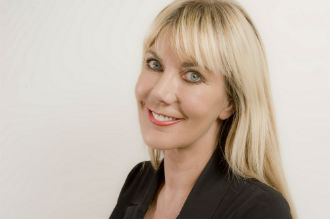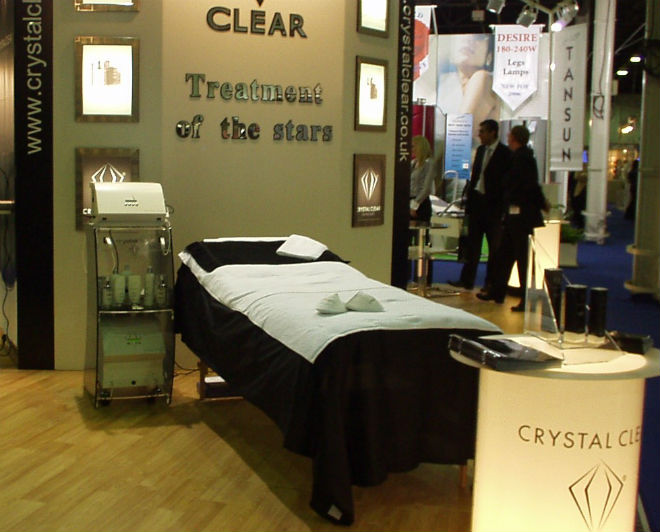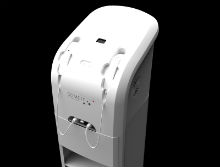Changing Faces
Crystal Clear's Sharon Hilditch tells Lucy Douglas how the industry has changed over the brand's 20-year history, and about the new technologies she is working on.
Twenty years is a long time in the beauty industry. Back in 1995, gel polish was far from becoming the bread-and- butter treatment for the high-street salon, growth factors and stem cells had yet to find themselves so readily available in skincare, and consumers had not yet been awakened to the impressive results of non-invasive machine treatments. Yet Crystal Clear’s founder Sharon Hilditch was launching her first product to the market – the brand’s first microdermabrasion machine.
Now, 20 years on, the Liverpool-based brand boasts nine machines in its portfolio and 30 skincare products, some 5,000 UK salon accounts as well as export to 30 countries around the world.
 A qualified therapist herself, Hilditch ran her own hair and beauty salon before founding CrystalClear. “I was very intos kincare and looking after the skin,” she says, reflecting on the early days of her career. “But I didn’t like the other treatments. I was no good with a wax; that wasn’t really for me.”
A qualified therapist herself, Hilditch ran her own hair and beauty salon before founding CrystalClear. “I was very intos kincare and looking after the skin,” she says, reflecting on the early days of her career. “But I didn’t like the other treatments. I was no good with a wax; that wasn’t really for me.”
While maintenance treatments may not be her thing, a background running salons means she understands better than many the challenges that salon owners face on a daily basis. “We’ve come through the most horrendous recession, and that’s taken its toll,” she says. “Only the strong have survived that, so I think if you have got to this point, you can only go forward.”
But in spite of a tricky few years, Hilditch thinks now is a great time to be in the beauty industry. “Anti-ageing is massive today. Years ago, it was a luxury to go to a beauty salon. Now, people who 20 years ago would never have gone to a salon will come for professional treatments and think its normal.”
What’s more, she thinks now is a great time to be starting out in the industry. “Therapists today have a lot more opportunity than we ever did,” she says. “There are more career paths you can go down. You can become a specialised skincare practitioner; you can do a level-four qualification and start doing aesthetic treatments.” More Government funding and small business support is available than 20 years ago, she points out, and social media allows salon owners to market their businesses for free.
Socially savvy
“The older salons have to move with the times and they have to be clued up on social media. It’s about who shouts the loudest”
In fact, she says social media is possibly the greatest difference in the market today although it’s not something that she is very comfortable with. “I hate Twitter,” she laughs. “I’ve had to grow with the company in respect to the changes of how you advertise and market your business.” She may not like it, but she is well aware that in order to be successful today it is a vital tool.
“My daughter has just opened her own make-up studio, and she’s never placed an advert,” she says. “She does everything on Instagram, and she’s really busy. It costs her nothing, only her time.”
 It’s because of this, she says, that young therapists and salon owners today are in a stronger position than their colleagues who have been in the industry for years. “The older salons have to move with the times and they have to be clued up on social media,” she says. “It’s all about who shouts the loudest.”
It’s because of this, she says, that young therapists and salon owners today are in a stronger position than their colleagues who have been in the industry for years. “The older salons have to move with the times and they have to be clued up on social media,” she says. “It’s all about who shouts the loudest.”
She also warns salon owners not to underestimate the power of celebrity endorsement, and it’s not just about the A-list names, either. “One of the Towie girls tweeted something about us and for a while our Twitter went mad. Obviously, people trust in celebrities,” she explains. “We’ve often used celebrities, but we tended to go for more A-listers and then shout about it in the national press. But with Twitter it’s just so quick. They come into the salon for a treatment, and it’s out there right away, picking up momentum.”
Advance ahead
“Therapists today have a lot more opportunity. There are a lot more positions or careers that you can go into now”
As a manufacturer of salon hardware, the other major industry change Hilditch has noticed since she launched Crystal Clear is the growth in advanced treatments. “We’re very much an aesthetic industry now,” she says. “When we first launched microdermabrasion, we were in a gap between doctor treatments and the salon.
“Back then, it was more high-profile salons that took it on; it wasn’t a staple part of your menu. Now it definitely is. If you’re opening a salon today, then you’re going to look at microdermabrasion.”

This growth in demand for advanced treatments and the need to stay ahead of the curve pushed Hilditch to develop Crystal Clear’s most successful product yet – Comcit, a device that combines cryotherapy, oxygen therapy and microneedling. Since its launch 18 months ago at Professional Beauty North, Comcit has become the best-selling machine in the brand’s portfolio, and even Hilditch is surprised at its success. “I must say, I didn’t expect it to fly quite as quickly as it did,” she says. “Prior to Christmas, we couldn’t make them quick enough, but that’s a nice problem to have.”
Comcit was three years in the making, and Hilditch is fastidious about new product development “18 months in I changed the design completely,” she explains. “On the original machine that I’d done, the results just weren’t what I really wanted from it, so I went back to the drawing board. But I’m glad I did. Anything I do, I have to totally believe in and have a passion for, otherwise I can’t promote it.”
She is applying that same level of scrutiny to the new device she is currently developing, which had been slated for launch in February but now looks likely to hit the market in the summer or at the autumn trade shows. “You can’t rush things,” she says. She remains tight-lipped about the spec of the new device, but does reveal that it will use cryotherapy alongside other technologies, and will be primarily for body treatments.
“We haven’t really done a body machine, so that’s what we’re concentrating on,” she says, and it’s an area of the market she thinks will grow. “You only have to look at personal trainers – 15 years ago it wasn’t really heard of. Now everybody talks about their personal trainer, and it’s just normal. We’re all keen to ensure we look and feel the best we can.”
It won’t be long until Hilditch is ready to reveal this new device to the market, and then it will be on to the next big development. PB
Crystal Clear's Sharon Hilditch tells Lucy Douglas how the industry has changed over the brand's 20-year history, and about the new technologies she is working on.
Twenty years is a long time in the beauty industry. Back in 1995, gel polish was far from becoming the bread-and- butter treatment for the high-street salon, growth factors and stem cells had yet to find themselves so readily available in skincare, and consumers had not yet been awakened to the impressive results of non-invasive machine treatments. Yet Crystal Clear’s founder Sharon Hilditch was launching her first product to the market – the brand’s first microdermabrasion machine.
Now, 20 years on, the Liverpool-based brand boasts nine machines in its portfolio and 30 skincare products, some 5,000 UK salon accounts as well as export to 30 countries around the world.
 A qualified therapist herself, Hilditch ran her own hair and beauty salon before founding CrystalClear. “I was very intos kincare and looking after the skin,” she says, reflecting on the early days of her career. “But I didn’t like the other treatments. I was no good with a wax; that wasn’t really for me.”
A qualified therapist herself, Hilditch ran her own hair and beauty salon before founding CrystalClear. “I was very intos kincare and looking after the skin,” she says, reflecting on the early days of her career. “But I didn’t like the other treatments. I was no good with a wax; that wasn’t really for me.”
While maintenance treatments may not be her thing, a background running salons means she understands better than many the challenges that salon owners face on a daily basis. “We’ve come through the most horrendous recession, and that’s taken its toll,” she says. “Only the strong have survived that, so I think if you have got to this point, you can only go forward.”
But in spite of a tricky few years, Hilditch thinks now is a great time to be in the beauty industry. “Anti-ageing is massive today. Years ago, it was a luxury to go to a beauty salon. Now, people who 20 years ago would never have gone to a salon will come for professional treatments and think its normal.”
What’s more, she thinks now is a great time to be starting out in the industry. “Therapists today have a lot more opportunity than we ever did,” she says. “There are more career paths you can go down. You can become a specialised skincare practitioner; you can do a level-four qualification and start doing aesthetic treatments.” More Government funding and small business support is available than 20 years ago, she points out, and social media allows salon owners to market their businesses for free.
Socially savvy
“The older salons have to move with the times and they have to be clued up on social media. It’s about who shouts the loudest”
In fact, she says social media is possibly the greatest difference in the market today although it’s not something that she is very comfortable with. “I hate Twitter,” she laughs. “I’ve had to grow with the company in respect to the changes of how you advertise and market your business.” She may not like it, but she is well aware that in order to be successful today it is a vital tool.
“My daughter has just opened her own make-up studio, and she’s never placed an advert,” she says. “She does everything on Instagram, and she’s really busy. It costs her nothing, only her time.”
 It’s because of this, she says, that young therapists and salon owners today are in a stronger position than their colleagues who have been in the industry for years. “The older salons have to move with the times and they have to be clued up on social media,” she says. “It’s all about who shouts the loudest.”
It’s because of this, she says, that young therapists and salon owners today are in a stronger position than their colleagues who have been in the industry for years. “The older salons have to move with the times and they have to be clued up on social media,” she says. “It’s all about who shouts the loudest.”
She also warns salon owners not to underestimate the power of celebrity endorsement, and it’s not just about the A-list names, either. “One of the Towie girls tweeted something about us and for a while our Twitter went mad. Obviously, people trust in celebrities,” she explains. “We’ve often used celebrities, but we tended to go for more A-listers and then shout about it in the national press. But with Twitter it’s just so quick. They come into the salon for a treatment, and it’s out there right away, picking up momentum.”
Advance ahead
“Therapists today have a lot more opportunity. There are a lot more positions or careers that you can go into now”
As a manufacturer of salon hardware, the other major industry change Hilditch has noticed since she launched Crystal Clear is the growth in advanced treatments. “We’re very much an aesthetic industry now,” she says. “When we first launched microdermabrasion, we were in a gap between doctor treatments and the salon.
“Back then, it was more high-profile salons that took it on; it wasn’t a staple part of your menu. Now it definitely is. If you’re opening a salon today, then you’re going to look at microdermabrasion.”

This growth in demand for advanced treatments and the need to stay ahead of the curve pushed Hilditch to develop Crystal Clear’s most successful product yet – Comcit, a device that combines cryotherapy, oxygen therapy and microneedling. Since its launch 18 months ago at Professional Beauty North, Comcit has become the best-selling machine in the brand’s portfolio, and even Hilditch is surprised at its success. “I must say, I didn’t expect it to fly quite as quickly as it did,” she says. “Prior to Christmas, we couldn’t make them quick enough, but that’s a nice problem to have.”
Comcit was three years in the making, and Hilditch is fastidious about new product development “18 months in I changed the design completely,” she explains. “On the original machine that I’d done, the results just weren’t what I really wanted from it, so I went back to the drawing board. But I’m glad I did. Anything I do, I have to totally believe in and have a passion for, otherwise I can’t promote it.”
She is applying that same level of scrutiny to the new device she is currently developing, which had been slated for launch in February but now looks likely to hit the market in the summer or at the autumn trade shows. “You can’t rush things,” she says. She remains tight-lipped about the spec of the new device, but does reveal that it will use cryotherapy alongside other technologies, and will be primarily for body treatments.
“We haven’t really done a body machine, so that’s what we’re concentrating on,” she says, and it’s an area of the market she thinks will grow. “You only have to look at personal trainers – 15 years ago it wasn’t really heard of. Now everybody talks about their personal trainer, and it’s just normal. We’re all keen to ensure we look and feel the best we can.”
It won’t be long until Hilditch is ready to reveal this new device to the market, and then it will be on to the next big development. PB

